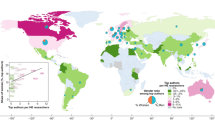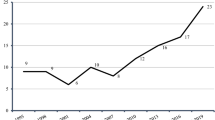Abstracts
An analysis of 9,957 papers published by Indian scientists and indexed by WoS in 12 sub-disciplines of life sciences during 2008–2009 indicates that academic institutions produced the highest number of papers. Of these, 340 (3.4 %) were contributed by female scientists exclusively and 4,671 (47 %) were written jointly by male and female scientists. Women scientists produced about 0.36 papers per author, while their male counter parts produced 0.50 papers per author. Significant number of women scientists was first author and about 23 % were corresponding authors in papers written jointly by both sexes. Women scientists emphasized on the sub-discipline of cell biology and reproductive biology and male scientists emphasized on the sub-discipline of zoology. Women scientists work in small teams and have very less international collaborative papers. Women scientists publish in low impact factor and domestic journals and also are cited less as compared to their male counter parts.
Similar content being viewed by others
References
Abramo, G., Andrea D’Angelo, C., & Caprasecca, A. (2009). The contribution of star scientists to overall sex differences in research productivity. Scientometrics, doi:10.1007/s11192-008-2131-7.
Ajiferuke, I., Burrel, Q., & Tague, J. (1988). Collaborative coefficient: A single measure of the degree of collaboration in research. Scientometrics, 14, 421–433.
Arruda, D., Bezerra, F., Neris, V. A., et al. (2009). Brazilian computer science research: Gender and regional distributions. Scientometrics, 79, 655–669.
Arunachalam, S., Srinivasan, R., & Raman, V. (1998). Science in India—A profile based on India’s publications as covered by Science Citation Index-1989–1992. Current Science, 74, 433–441.
Bal, V. (2005). Women scientists in India: Nowhere near the glass ceiling. Current Science, 88, 872–878.
Bordons, M., Morillo, F., Fernandez, M. T., & Gomez, I. (2003). One step further in the production of bibliometric indicators at the micro level: Differences by gender and professional category of scientists. Scientometrics, 57, 159–173.
Borrego, A., Barrios, M., Villarroya, A., et al. (2010). Scientific output and impact of postdoctoral scientists: A gender perspective. Scientometrics, doi:10.1007/s11192-009-0025-y.
Department of Science and Technology, Government of India. Retrieved April 4, 2013, from http://www.dst.gov.in.
Department of Science and Technology, Women scientists programs. Retrieved April 4, 2013, from http://www.dst.gov.in/scientific-programme/women-scientists.htm.
Fox, M. F. (2005). Gender, family characteristics, and publication productivity among scientists. Social Studies of Science, 35, 131–150.
Garg, K. C., & Dutt, B. (1992). Bibliometrics of Indian science as reflected through Science Citation Index. Journal of scientific and industrial research, 51, 329–340.
Garg, K. C., Dutt, B., & Kumar, S. (2006). Scientometric profile of Indian science as seen through Science Citation Index. Annals of Library and Information Studies, 53, 114–125.
Goel, K. (2002). Gender differences in publication productivity in psychology in India. Scientometrics, 55, 243–258.
Gupta, B. M., & Dhawan, S. M. (2009). Status of India in science and technology as reflected in its publications output in the SCOPUS database—1996–2006. Scientometrics, 80, 473–490.
Gupta, B. M., Kumar, S., & Aggarwal, B. S. (1999). A Comparison of productivity of male and female scientist of CSIR. Scientometrics, 45, 269–289.
Gupta, N., & Sharma, A. K. (2002). Women academic scientists in India. Social Studies of Science, 32, 901–915.
Hasan, S. A., Sharma, M. K., Khilnani, S., & Luthra, R. (2012). Research productivity of female research scholars and their migration pattern in pursuit higher education and research. Current Science, 103, 611–612.
Hunter, L. A., & Leahey, E. (2010). Parenting and research productivity: New evidence and methods. Social Studies of Science, 40, 433–451.
Indian National Science Academy. (2004). Science career for Indian women: An examination of Indian women’s access to and retention in scientific careers. Report, New Delhi October 2004. Retrieved April 4, 2013, from http://www.insaindia.org/Scienceservice/science.htm.
Lariviere, V., Vignola-Gagne, E., Villeneuve, C., et al. (2011). Sex differences in research funding, productivity and impact: An analysis of Quebec university professors. Scientometrics, doi:10.1007/s11192-011-0369-y.
Ledin, A., Bornmann, L., Gannon, F., & Wallon, G. (2007). A persistent problem. EMBO Reports, 8, 982–987.
Lemoine, W. (1992). Productivity patterns of men and women scientists in Venezuela. Scientometrics, 24, 281–295.
Leta, J. (2003). The contribution of women in Brazilian science: A case study in astronomy, immunology and oceanography. Scientometrics, 57, 339–353.
Lewison, G. (2001). The quantity and quality of female researchers: A bibliometric study of Iceland. Scientometrics, 52, 29–43.
Long, J. S. (1993). Women in science part 2, the impact enigma-why women biochemists papers are more cited than men’s. Current Comments, 11, 259–269.
Mauleón, E., & Bordons, M. (2006). Productivity, impact and publication habits by gender in the area of materials science. Scientometrics, 66, 199–218.
Mc Millan, G. S. (2009). Gender differences in patenting activity: An examination of the US biotechnology industry. Scientometrics, 80, 683–691. doi:10.1007/s11192-008-2101-0.
Moya-Anegón, F., Chinchilla-Rodríguez, Z., Vargas-Quesada, B., et al. (2007). Scientific output by gender in Spain (Web of Science, 2004). Retrieved June 2, 2013, from www.academia.edu/1430683/Scientific_Output_by_Gender_in_Spain_WebofScience_2004.
Mozaffarian, M., & Jamali, H. R. (2008). Iranian women in science: A gender study of scientific productivity in an Islamic country. Aslib Proceedings, 60, 463–473.
Muñoz-Muñoz, A. M. (2005). The scholarly transition of female academics at the University of Granada (1975–1990). Scientometrics, 64, 325–350.
Naldi, F., Luzi, D., Valente, A., & Parenti, H. V. (2004). Scientific and technological performance by gender. In H. F. Moed et al. (Eds.), Handbook of quantitative science and technology research (pp. 299–314). The Netherlands: Kluwer Academic Publishers.
Penas, C. S., & Willett, P. (2006). Gender differences in publication and citation counts in librarianship and information science research (Brief communication). Journal of Information Science, 32, 480–485.
Prpic, K. (2002). Gender and productivity differentials in science. Scientometrics, 55, 27–58.
Pudovkin, A., Kretschmer, H., Stegmann, T., & Garfield, E. (2012). Research evaluation part 1: Productivity and citedness of German medical research institute. Scientometrics, doi:10.1007/s11192-012-0659-z.
Schubert, A., & Braun, T. (1986). Relative indicators and relational charts for comparative assessment of publication output and citation impact. Scientometrics, 9, 281–291.
Smykla, E., & Zippel, K., (2010). Literature review: Gender and international research collaboration. Retrieved June 2, 2013, from http://nuweb.newedu/zippel/nsf-workshop/Lit Review Oct 22_2010.pdf.
Sotudeh, H., & Khoshian, N. (2013). Gender differences in science: The case of scientific productivity in nano science and technology during 2005–2007. Scientometrics, doi:10.1007/s11192-013-1035-7.
Symonds, M., Gemmell, N., Braisher, T., et al. (2006). Gender differences in publication output: towards an unbiased metric of research performance. PLoS One. www.plosone.org.
Telegraph India. Retrieved April 5, 2013, from http://www.telegraphindia.com/1100928/jsp/frontpage/story_12991055.jsp.
Vela, B., Caceres, P., & Cavero, J. M. (2012). Participation of women in software engineering publications. Scientometrics, 93, 661–679.
Webster, B. M. (2001). Polish women in science: A bibliometric analysis of polish science and its publications, 1980–1999. Research Evaluation, 10, 185–194.
Author information
Authors and Affiliations
Corresponding author
Additional information
K.C.Garg—Ex-chief scientist, CSIR-NISTADS.
Appendix 1
Rights and permissions
About this article
Cite this article
Garg, K.C., Kumar, S. Scientometric profile of Indian scientific output in life sciences with a focus on the contributions of women scientists. Scientometrics 98, 1771–1783 (2014). https://doi.org/10.1007/s11192-013-1107-4
Received:
Published:
Issue Date:
DOI: https://doi.org/10.1007/s11192-013-1107-4




